http://www.taxpolicy.com/batt/
What is Land Rent?
John Houseman, an actor perhaps most widely known as Professor Kingsfield in the long-running TV series, The Paper Chase, later became the pitchman for Smith Barney. In that advertisement, his tag line was "We make money the old-fashioned way -- we earn it."
That we should earn our money rather than live off the efforts of others seems a simple enough moral tenet. But it seems to have lost its cogency in contemporary economic thought. More than a century ago John Stuart Mill noted that
Today, on the other hand, the unearned
surplus which classical economists called rent attaches to
monopoly titles -- largely the scarce goods and services of
nature like locational sites, and has totally disappeared
from economic calculus. Yet this is the primary vehicle by
which wealth is captured by economic elites. If government
recaptured the socially-created economic rent from land
sites that comes from the investment of the collective
community, we could eliminate other taxes that are both
more onerous and create a drag on the economy that makes us
all poorer. There are many websites that explain how this
can be done, ways that not only beget greater economic
efficiency but also bring about economic
justice.(2) The
surplus economic rent that derives from community effort is
its rightful entitlement.
Where does economic rent most tend to lodge? In the center
of cities where people are. And also proximate to heavy
social investments -- such as railroad and metro stations,
public and office buildings, hotels and conference centers,
and anywhere there is high traffic in personal or market
exchanges. The land value in New York City is higher than
all the rest of the New York state combined, even though it
is only a minute fraction of the area. One 9-acre site
south of the United Nations Building was recently sold to a
developer intent on building luxury condominiums facing the
East River. That site sold for $680 million, and would have
been higher had the existing structure, an obsolete power
plant, not have to be razed.(3) Land values in any given area tend
to rise and fall together, and tend also to form a contour
somewhat comparable to a topographical survey map. In a
city's center are the highest value locations, analogous to
a mountain peak. Once one departs from that center, land
values fall in direct proportion to the value of their use,
made more or less attractive by whatever social attributes
are provided in the proximate areas. Two illustrations from
small and medium sized cities in the United States
illustrate the point.
Case 1: Ithaca, New York: Tompkins
County, where the city of Ithaca sits at the center, has
land values many times those within a short walk. Dividing
the county land parcels into quintiles, the highest fifth
have values of $56,000 per acre and above. The lowest fifth
have a value of less than $3,000 per acre. The high value
area collectively constitutes only a minute proportion of
the total number of square miles because most of it is farm
or forest land.
Tompkins County
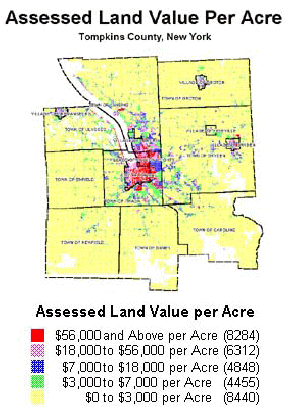
Case 2: Des Moines, Iowa: Polk
County, where Des Moines sits near the center, has land
values even more disparate between urban and rural
locations. The highest quartile there are those $97,400 per
acre and above, the single highest parcel of all worth an
astonishing $31.4 million per acre. Yet, the lowest
quartile, a roughly equal number of far larger parcels, all
have a value of less than $30,000 per acre.
Polk County, Iowa
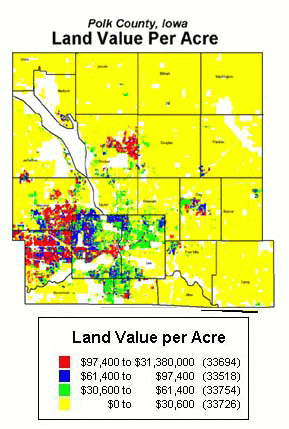
Yet because society has not elected to recapture the
socially created land value of the highest priced parcels,
the rent that accrues to those sites becomes the windfall
gain of their titleholders. Regardless whether those
titleholders use their landsites productively or not, the
continuing rent that accretes in those land sites drives up
their market price. This forces developers who might wish
to improve parcels not used to best advantage to settle
instead on sites that are sub-optimal. Were the rent
collected from the current titleholders of those sites,
their use would be encouraged to the full extent that their
value warrants. They would be encouraged to seek the best
return for the carrying costs of those underused parcels --
the higher the tax of rent, the greater the incentive to
use landsites well.
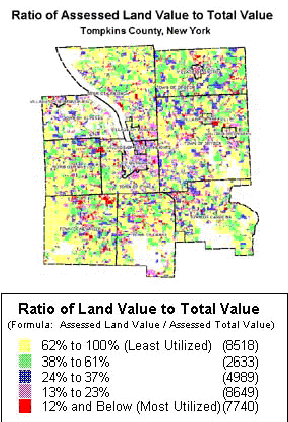
To secure the fullest results of collecting land rent,
structures should be removed entirely from revenue base and
imposed on the land component alone. Phasing out the tax
burden on improvements and placing it on land value alone
removes the penalty now placed on those who do invest in
and maintain their buildings. And, as mentioned earlier, it
prompts titleholders to abjure practices for speculative
gain. If only the land value component of the property tax
is collected and tax on buildings is eliminated, those who
do use landsites to the full extent that their value
warrants are rewarded for doing so.
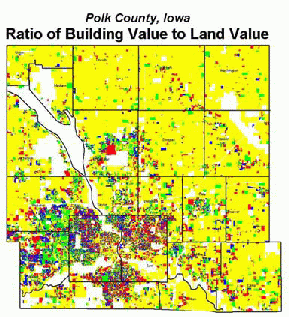 |
|
|||||||||||||||||||||||||
The failure to collect site rent leads to a distortion in land use configurations. If patterns unfolded along the lines of both social preference and economic efficiency, high value landsites would tend to have high value buildings, and low value landsites would tend to be vacant or have very modest buildings. Consistent with this, urban centers sites would tend to have office and commercial use, surrounded by lower-value residential land uses, and still further out would be farms and forests. The ratio of building to land value, land to total value (or for that matter any other ratio between buildings, land, and total values) would be relatively constant throughout a region. Instead, the ratio of land value to total value consistently tends to reveal a patchwork of random development. This inefficient settlement of land sites is what we know as sprawl.
Land Rent is Capitalized Transportation Cost
There is another dimension to the distortion of land use in contemporary life. That is the heavy subsidy granted to motor vehicle transportation services. Estimates are that the typical driver pays only about a tenth of the true cost of his travel; society picks up the rest. This profuse subsidy paid to private automobile and truck transportation further encourages people to locate on sites at far greater distances from where they would choose than if they had to pay the full burden of that travel.
From the standpoint of an economic geographer, and for some land economists, land rent is simply capitalized transportation cost. Land rent is the surplus generated by social activity on or in the vicinity of locational sites which accrues to titleholders of those parcels. Whether or not it is recaptured by public policy, rent is a natural factor deriving from the intensive use of natural capital. More intensive use of high value landsites leads to site configurations that are less dependent upon transportation services. People can access them easily even by walking. One must remember that transportation is not an end in itself but rather a means. This is something often forgotten even by urban planners, the distinction between accessibility and mobility. As explained well in a recent text, The Geography of Urban Transportation:
The result is that we do an awful lot of traveling to get what and where we want. We have paid enormously for mobility even at the expense of access. Subsidizing motor vehicle transportation makes the problem worse! Author Kirkpatrick Sale recognized this when he argued that
Site Rent and Transportation Costs
Linked
Higher density development has all the economies of scale,
savings in cost, reduction in externalities, dividends in
community and political enhancement, and benefits to urban
areas that we all say that we want. The greater the
proximity to points of desirable accessibility, the lower
are typically the transportation costs. Conversely, sites
remote from the urban centers of greatest locational value
will have higher transportation costs. When the fixed costs
of transportation infrastructure and parcel site
improvements are accounted for (which tend to be relatively
the same regardless of location), one is left with the
marginal costs of operations.(6) This is illustrated most easily in
conceptual Figure 1:
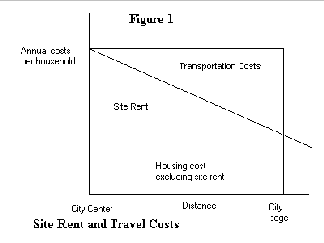
This relationship has been demonstrated more empirically in
a recent study by the Urban Land Institute. The author
concluded that, for Portland Oregon,
That's the savings for living closer to the urban center
by ten miles. If the urban resident has to rely upon a car
nonetheless, subtracting some $3,000 annual travel expenses
will still leave him paying again that much, and likely
more, to own a car. Seven years ago James Kunstler put the
true costs along with other experts at about $6,100
annually.(8) The
American Automobile Association calculated that a car
driven 15,000 miles in 2001 cost 51¢ per mile or
$7,650.(9) Even that
figure reflects only direct costs to the driver, not those
passed on to society. One study calculated that the total
costs of motor vehicle transportation to our society equal
approximately one-fourth of our Gross Domestic Product
(GDP).(10) In 1991
road user fees totaled only about $33 billion whereas the
true costs to society were ten times
that;(11) put
another way, drivers paid only 10% of the true costs of
their motor vehicle use.(12)
The latter figures include externalities like pollution and
the costs of highway crashes. Hortatory public pleas for
people to tune up their engines so they pollute less,
inflate their tires properly, and drive more safely are not
likely to change the reality that people are forgetful and
fallible. Regardless, pollution-free cars are not
available; people must drive to participate in this
society. The consequences of SO2, CO2, and ozone are no
longer a matter of debate; they are scientific fact.
Despite frequent headlines about replacing the internal
combustion engine, all the realistic substitutes also rely
upon fossil fuel power directly or indirectly; solar
powered cars are far in the future, if at all, and also
fail to deal with any transition. And every person driving
his or her own car multiplies the probabilities of
accidents. Those crashes alone, nothing else, represents a
figure equal to 8 percent of the American
GDP.(13) In human
terms nationally, this is about 43,000 deaths and 2 million
hospitalizations annually. When people step into a car they
are seldom mindful of such odds. However, if the direct
pecuniary costs of driving increase in any substantial way,
such as for an increase in motor fuel as many experts
forecast, there will surely be significant changes in the
tradeoffs involved in housing/transportation
choices.(14) And
indeed a radical shift in the use of petroleum looms
closely on the horizon. The consensus view of most oil
geologists is that worldwide oil extraction will peak
sometime in about 2009 or shortly thereafter, then to fall
off rather quickly. That graphic record and projection of
oil mining is shown in Figure 3.(15) Making costs visible and linked to
private personal behavior is one way to ensure that
transportation pays its own way -- if it isn't already too
late to save us.

Public opinion polls are practically unanimous in their
demonstration of the kind of environment most Americans say
they would like to live in.(16) Sociological studies have
documented graphically how alienating the car-dependent
environment really is. There is an inverse correlation
between the ability of a street to move and to park cars
and trucks, and the amount of social interaction between
neighbors on that street. One study two decades ago
compared three similar residential streets in San
Francisco, with different levels of traffic volumes.
Residents on the different streets were asked to indicate
on the base maps of their streets where friends and
acquaintances lived. Those living on streets with the least
traffic volume had three times as many friends and twice as
many acquaintances as those living on the streets with
heavy traffic volumes.(17)(18) More
recently Harvard Professor Robert Putnam has made similar
findings in his book Bowling Alone, and concluded that
every ten minutes of additional commuting time means ten
percent less time devoted to communal activity. Driving is
no longer regarded as fun, not on today's typically
congested highways. There was a time when most people drove
cars for pleasure; today people resent their having to
drive so much and often see driving as a
burden.(19) It is
also no accident also that on measures of livability, those
locations regarded as most attractive are also the ones
that are most bicycle-friendly.(20) A number of recent books and their
popularity reflect resentment over our forced dependency on
motor vehicle transportation Jane Holtz Kay's Asphalt Nation, Clay McShane's Down the Asphalt Path, Wolfgang Zuckerman's
End of the Road, and Katie Alford's
Divorce Your Car are only a few
such examples.(21)
But despite their vague discomfort people typically lack
the perspicacity to incorporate these non-pecuniary costs
into their decisions about locational choice.
Correcting Distortions by Pricing:
Increasing the Collection of Land Rent
Recovering the economic rent from urban parcels helps
people to appreciate the true costs of the transportation
versus location trade-off. It brings the carrying costs of
site choices back to the present time and makes them
comparable with travel choices. The payment of site rent
becomes an operating cost. The other corrective policy
needed is to raise transportation costs to a level
commensurate with their full value as private goods.
Transportation user fees, in the form of motor fuel taxes,
green taxes, congestion fees, and administrative costs (for
the administration of drivers' licenses and registration
fees) could easily provide the needed price corrections to
bring into balance marginal transportation costs and land
rent collection. Doing so would equilibrate choices between
people living and working in high rent urban centers and
those in peripheral low rent (but higher travel cost)
locales.
Figure 2 shows how a tax on land value (or alternatively
the tax on land rent) coupled with the proper design of
transportation fees can equilibrate the competitive
advantage of markets in urban areas relative to suburbs,
thereby reducing, and perhaps even reversing, the
centrifugal forces of sprawl development. The land tax
cannot alone redress the problem, especially so long as
such inordinate social subsidies are granted to private
motor vehicle transportation services. Nor can
transportation fees, raised to a level fully commensurate
with the social and private costs they incur, alone ensure
that the price of locations will be matched. But to the
extent that both are assessed, they reach far toward
correcting this disequilibrium. One could even argue that
all site rent should be recaptured by society and that all
transportation costs that are identifiable as consumption
of private goods should be priced accordingly. Some
advocates even suggest that doing so will not only foster
economic efficient behavior but also provide sufficient
revenue for a citizen's dividend consistent with economic
justice.
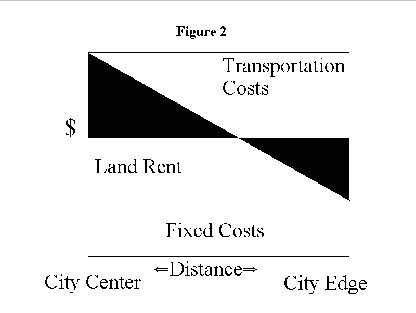
Arriving at the appropriate revenue formulas is the
challenge. Recapturing land rent is likely best achieved by
setting the rates at levels that stabilize the market price
of landsites in the face of speculative pressures. Because
the collection of rents fosters economic activity in the
regions of highest value, it may just be that market prices
will remain stable even with very high levies. The downward
pressure on market prices exerted by a tax is countered by
the increased incentive to improve parcel sites with the
highest value. Many economists as early as the French
physiocrats have argued that ultimately all tax revenues
come from rents in any case; that it is only a question of
how much they are shifted through to other sectors of the
economy before they are collected. Professor Mason Gaffney
explains this by noting that
Lest one believe that this excess burden, or so-called deadweight loss, is a negligible drag on the economy, studies show just the opposite. One study calculates that it was equal to about 20 percent of the total US economy in the mid-1990s, annually at least one trillion dollars in lost output.(23) Put another way, a well designed efficient revenue structure would allow productivity to rise by that amount and effectively make our income that much higher. For Great Britain, the comparable figure was shown to be £400 billion annually.
Deadweight loss is a concept understood by economists but not by the general public. But this is likely to change as discussion about the merit of various taxation approaches is presented to the public. Nations in the European Community are now required to publish their calculations about the deadweight loss of the various tax schemes being reviewed, precisely because of the recognition of its importance as a factor of production.(24)

The one kind of tax where there is no deadweight loss whatsoever is that imposed upon an base with inelastic supply. Since land and some other elements of nature cannot be increased in quantity resulting in a completely vertical supply curve, no inefficiency is incurred by such a tax. Consider two cases of a tax commonly found worldwide on real estate. Because a real property tax is actually two taxes from the standpoint of economic dynamics -- the tax on the land component and the tax on the improvement component, each is considered here as a separate case. In the first case, the tax on the land component alone is illustrated. In the other case, the tax on the improvement component (i.e. the building) is shown. What happens?
The tax on land alone is completely capitalized in the market value of the land parcel and is not passed forward to the tenant. This is important, because when the roughly 1/3 of all American households that rent rather than own their own homes are removed from the burden of property taxation, it has the effect of making the land tax far more progressive. Those land parcels that do pay taxes are split between residential and non-residential titleholders. Even though the residential households are likely to constitute the overwhelming number of parcels in the tax base, they are likely to bear only about half the taxes paid, the remaining share borne largely by commercial sites. Agricultural parcels may in some instances represent a large area of land, but it is likely to be of far lower market value and represent less than five percent of the revenue paid. The land component of a tax on real property then is actually highly progressive.
Incidence of a Tax on Land
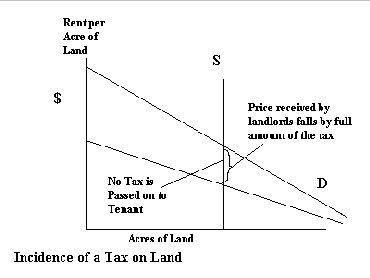
Consider now the tax on the improvement portion of the property parcel. Here, depending upon the slope of the supply curve and the demand curve, the tax is likely to be passed forward to a greater or lesser extent to the tenant. Very little of it in fact is typically borne by the landlord. The existence of the tax on structures incurs a depressing effect upon the rate of investment, just like all such taxes with more than zero elasticity. And the greater scarcity of sites for rent, either commercial or residential, has the impact of driving up prices for their use. What is even more significant, as noted earlier, is that the shift of taxes off improvements and onto landsites encourages the use of those sites to the full extent of their locational value, thereby halting and even reversing the centrifugal forces of sprawl development. Greater investment in high value landsites creates greater density and proximity in the community, enhancing the accessibility of those sites to one another and reducing the need for transportation mobility.
Correcting Distortions by Pricing: Increasing the Recovery of Transportation Service Costs
With respect to charges upon transportation services and externalities, there are several components to a proper pricing design.(25) The first step to proper pricing is to identify the proportion of transportation services that ought rightly to be seen as private goods as opposed to public goods.(26) Although this is a daunting task, the frequent figure used is 80 percent - 20 percent proportion.
- The public good proportion of road use reflects the amount of reliance by services provided by the government and associated agencies like mail service, national defense, public safety (ambulance, police and fire departments), and so on.
- The private use of the roads constitutes the overwhelming amount of its use. This means that as a rule 80 percent of the highway use charges should be paid by individual drivers, directly or indirectly.
- capital investment,
- maintenance costs,
- regulation costs,
- environmental externalities and
- congestion costs.
As noted earlier, capital investments affect the market value of locational sites by conveying rent to those in any way benefitting from the service. That rent accruing to proximate sites and can easily recaptured to pay off the debt service of project construction. Typically rent collection is ignored, however, left instead in the hands of titleholders whose sites are serviced by the infrastructure investment. This drives speculation in land, with all the negative effects it brings both economically and politically. In fact the rent created by capital investment in transportation can be enormous.
- One nine-mile stretch of interstate highway in Albany, New York, costing $125 million to construct has yielded $3.8 billion in increased land values within just two miles of its corridor in the 40 years of its existence.(27) This is a thirty-fold return in a timespan typically used for bond repayment!
- The Washington Metro created increments in land value along much of the 101-mile system under of construction in 1980 that easily exceeded $3.5 billion, compared with the $2.7 billion of federal funds invested in Metro up until that time.(28) No doubt the return is far greater today.
Maintenance costs on the other hand are best paid for from user fees, and can range from excise taxes on motor fuel, tires, heavy truck charges and others still. Such pricing has received considerable attention in recent years, even though it has been difficult to implement for political reasons. Heavy trucks, for example, pay special mileage charges, which should ideally be based upon axle-weight and distance, commensurate with the wear and tear on the roads that they cause. High-tech innovations using transponders for electronic road pricing according to time and place of vehicle travel are being explored and implemented in Hong Kong, Singapore, New Zealand and on modest scales elsewhere.(29) The virtue of a tax on motor fuel, at least for automobiles, is that charges are roughly commensurate with miles driven if rates are set at the proper levels. But electronic road pricing can be far more precise if concerns about personal privacy can be overcome by computers that calculate user charges based solely upon point calculations. Bringing prices into line with marginal costs is the most efficient and equitable way to pay for highway transportation services, and one can expect to witness significant advances in this realm before too many years pass.
Separate from maintenance operations are the costs involved in the regulation and supervision of drivers and motor vehicles themselves. License and registration fees should ideally be designed only to recover the costs involved in their administration. To be sure, such administration may reach to operations beyond license plate bureaucracies to safety inspections, certain judicial functions, and so on. But charging for road use through such measures is not only inefficient but inequitable.(30)
Charging for pollution externalities of motor vehicle travel invites more complex issues. One approach widely explored involves reliance upon what are known as Pigou taxes, after noted British economist Arthur Pigou.(31) It attempts to recover the costs of externalities in the natural environment and even involving health damages. Yet Pigou taxes are more often talked about than actually implemented. Related to such designs are those growing out of the theories of Ronald Coase, designed not necessarily to recover the full social costs of negative externalities but rather to foster the most efficient economic choice among options, even if some parties are disadvantaged.(32) Taxes recovering such costs are most easily collected at the production stage -- at the wellhead or the refinery for oil, and from the manufacturer for tires and other materials.(33) Still a third approach is that represented by the Georgist tradition, which would recover the costs of specified pollution externalities by accepting them to the extent that the environment is capable of absorbing them, and charging polluters for the use of the environment as a sink for such wastes. This approach is particularly attractive as a way to charge for the release of noxious gases in motor vehicle exhaust.(34)
The last dimension of motor vehicle transportation charges can be designed to reflect the costs of congestion. To some extent, those costs are already borne by drivers since they pay in the value of their time for that lost by slowed traffic. But not everyone's time has the same value, and proper pricing of road use reflective of time and place is an attractive solution to maintaining the efficient flow of highway service. Here again, electronic road pricing can help with efficiency.
These pricing approaches taken together offer the prospect of both recovering costs in their varied forms as well as fostering efficient transportation services. There are grave misconception in how much fiscal policies distort social and economic behavior. And the fiscal policies that foster the greatest distortions of all are those involving road costs and the failure to collect economic rent. Rather than resort to traditional command-and-control approaches which are frequently just as cumbersome and distorting as current unthinking fiscal measures, now is an opportune time to consider models which will help us to get things right.
Costs of Conventional Taxes and Subsidies
The conventional property tax, one taxing both land values and improvement values, is analogous to a train with an engine at each end. The tax on land value fosters improvement on the parcels with the highest market and social value, while the tax on structures discourages that very same thing. No wonder it is that economic activities is stymied most in the urban centers and manifests itself in areas where the least imposition of all has taken hold. As scholar Jessica Matthews once put it,
Developing land use and transportation patterns that assume walkability or transit service rather than individual and private motor vehicles is the very definition of livability. Experts agree that the minimum density necessary to make public transit services economically viable is 10 to 12 households per acre, although cities developed in the post-automobile era, lamentably, one sees very little prospect of altering automobile dependency.(36) One study found that "the range of costs induced by spread-out development, . . [i.e.] houses built in sprawling developments, may cost 40 to 400 percent more to serve than if they were located close to major facilities, were clustered in continuous areas, and in corporate a variety of housing types."(37) But by bringing prices into line with costs, both on the transportation services side and on the site-rent side, it is possible both to foster those personal choice calculations that are consistent with sustainable urban environments.
There remains the problem, however, of rearranging a century of site choices, for both residential and commercial purposes, at a time when circumstances may not afford us the time or resources to make such shifts. Land uses, once established, tend to be intractably embedded, and buildings retain their use for work, commerce and livability for decades if not centuries. What will happen when the costs of transportation limit our mobility and our access to a level that energy costs allow? What will happen when suburbs, now the most attractive of residential location choices become irretrievably remote and inaccessible? If they do become the next century's slums, as observers like historian Kenneth Jackson predicts,(38) the United States may quickly find itself unable to compete economically and even survive politically in a fashion that it has enjoyed in the twentieth century.
1. Principles of Political Economy, bk.5, ch.2, sec.5.
2. For links to these, see www.slonet.org/~ied/links/hgeorge.html; and www.progress.org/cgo/index.html.
3. Charles W. Bagli, "Winning Bid to Develop 9 Acres Near U.N." New York Times, Sunday, January 2, 2000.
4. Susan Hanson, Editor, The Geography of Urban Transportation, Second Edition. New York: Guilford Press, 1995, p. 5. See also Elliott Sclar, Access for All: Transportation and Urban Growth, New York: Columbia University Press, 1980.
5. Kirkpatrick Sale, Human Scale. New York: Coward, McCann & Geoghegan, 1980, p. 256.
6. There is some empirical evidence for this. Anthony Downs notes that,
"Data on consumer spending in specific regions backs up these observations. The highest fraction of consumer spending on transportation was 22.8 percent in the Houston area, which is notorious for traffic congestion. The lowest was 15.3 percent in the New York City area, which has an extensive public transit system. But Houston households spent only 30.6 percent on housing, whereas New York households spent 36.9 percent. Combined, both types of spending were about the same in the two cities. Similar inverse relationships between housing and transportation spending prevailed in all of the 28 metropolitan regions for which data were available.
"Another piece of evidence that partially supports this relationship comes from "The Costs of Sprawl 2000," a recent study conducted by Rutgers University, the Brookings Institution and several other organizations. Part of the research examined how housing prices vary with distance from the regional downtown of each metropolitan area. Although only a few areas were analyzed, the study showed consistently that prices of similar homes tended to decline about 1.2 to 1.5 percent per additional mile from the regional downtown, except where proximity to the ocean had more influence on prices--as in Southern California. Meanwhile, longer-distance commutes added to fuel and travel-time costs by about the same amount per mile in every region. The study also found that per-mile housing-cost savings from added commuting distance were much larger in regions with absolutely very high housing costs than in those with absolutely low housing costs." "Can Transit Tame Sprawl?" Governing Magazine, January, 2002, p. 54.
7. Robert T. Dunphy, "The Cost of Being Close: Land Values and Housing Prices in Portland's High Tech Corridor," ULI Working Paper #660, October, 1998, www.uli.org/Pub/Pages/a_issues/660/a_trl44_cost.html.
8. James Howard Kunstler, Home From Nowhere: Remaking Our Everyday World for the 21st Century, New York: Simon & Schuster, 1996, Chapter 3: "Car Crazy," and www.isd.net/msp00050/driving.html.
9. www.ouraaa.com/news/library/drivingcost/. Driving 10,000 miles per year will typically cost 64.5¢ per mile or $6,450, and driving 20,000 miles per year will cost 45.8¢ per mile, $9,160.
10. Peter Miller and John Moffet The Price of Mobility: Uncovering the Hidden Costs of Transportation. Washington: Natural Resources Defense Council, 1993. This is somewhat more than the US Department of Transportation's own calculation. The latter uses only direct measurable pecuniary costs, and estimates the figure was in the neighborhood of $1 trillion for the year 1992, about 17 percent of GNP. (Converted to GDP would make it somewhat higher.) Since it fails to include externalities such as pollution, accidents, and other associated costs, it seems a reasonable estimate. Transportation Statistics Annual Report, 1994. Washington: Department of Transportation, Bureau of Transportation Statistics, 1994, pp.4-5.
11. See James J. MacKenzie, et. al., The Going Rate: What It Really Costs to Drive. World Resources Institute, Washington, 1992.
12. Road Kill: How Solo Driving Runs Down the Economy. Boston: The Conservation Law Foundation (May, 1994), p. 7. This study is a summary of a larger study done by Apogee Research, Inc., funded by the Joyce Foundation.
13. In 1988, a study by the Urban Institute calculated that $71 billion were borne in out-of-pocket costs, another $46 billion in lost wages and household production, and $217 billion in pain, suffering and lost quality of life. Translated into vernacular, the total of $334 billion in lost property, work time, and injuries and deaths. T. Miller, et al, The Costs of Highway Crashes, The Urban Institute, Washington, D.C., October, 1991.
14. See, for example, www.oilcrisis.org.
15. From http://dieoff.org.
16. David Savageau, Retirement Places Rated: All You Need to Plan Your Retirement or Select Your Second Home, New York: Prentice Hall Press, 1990; David Savageau and Richard Boyer, Places Rated Almanac, New York: MacMillan, 1993; Kevin Heubusch, Life in America's Small Cities, Buffalo: Prometheus Press, 1997; Norman D. Ford, The 50 Healthiest Places to Live and Retire in the United States, New York: Ballantine Books, 1991.
17. Donald Appleyard, Livable Streets, Berkeley: University of California Press, 1981.
18. Robert D. Putnam, Bowling Alone: The Collapse and Revival of American Community, New York: Touchstone Books, 2001.
19. In a study done by the Washington Post in the early 1990s, 25 percent of Americans are "road haters" who don't enjoy driving. Another 15 percent consider cars a necessary evil but take little interest in style, color or upkeep. Forty percent of drivers may be disenchanted, but except for those living in cities with good public transportation, driving remains the only reasonable way to get around. Cited in Steve Nadis and James J. McKenzie, Car Trouble (Boston: Beacon Press, 1993), p. ix.
20. Ford, p. 28.
21. Asphalt Nation: How the Automobile Took Over America and How we can Take it Back. New York: Crown Publishers, 1997; Down the Asphalt Path: The Automobile and the American City. New York: Columbia University Press, 1994; The End of the Road: The World Car Crisis and How we can Solve it. Cambridge: Lutterworth Press, 1991; Divorce Your Car: Ending the Love Affair with the Automobile. British Columbia: New Society Publishers, 2000. There are as many studies also of conspiracies about how the motor vehicle industry seduced or trapped the nation into such patterns: Jonathan Kwitney's "The Great Transportation Conspiracy," Harper's Magazine, February, 1981, which is based on the trial in a Chicago federal court in 1949, resulting in an indictment of GM, Firestone, Standard Oil, Phillips Petroleum, and Mack Trucks among others. Their crime as in forming a holding company called National City lines which proceeded in the preceding decade to buy up the public transportation services in dozens of US cities, and then scrapping them so that people would then become more automobile dependent. The corporations were fined $5,000 each, and the CEOs of each one $1. See United States Senate, Committee on the Judiciary, 93rd Congress, 2nd Session, "American Ground Transport: A Proposal for Restructuring the Automobile, Truck, Bus and Rail Industries," by Bradford C., Snell, February 26, 1974 (Washington: U.S. Government Printing Office, 1974); and two more books (among others!) With the same title: the first by Bill Vlasic and Bradley Stertz, Taken for a Ride: How Daimler Benz Drove Off with Chrysler. New York: HarperBusiness, June, 2001, and Jack Doyle: Taken for a Ride: Detroit's Big Three and the Politics of Pollution. New York: Four Walls, Eight Windows, 2000.
22. Professor Mason Gaffney, personal communication, December, 2001.
23. Fred Harrison (ed.), The Losses of Nations: Deadweight Politics versus Public Rent Dividends, London: Othila Press, 1998. See also "The Deadweight Loss of Income Taxes," National Center for Policy Analysis, There it is argued that "the efficiency loss from current income taxes is more than 30 percent. If Social Security taxes are included, there is a 50 percent efficiency loss." www.ncpa.org/pi/taxes/pd053000g.html.
24. Personal communication with Prof. Mikael Skou Anderson, National Environmental Research Institute, Denmark, at the Third Annual Global Conference on Environmental Taxation, Woodstock, Vt, April, 2002. For further explanation of the concept of excess burden, or deadweight loss, see www.xrefer.com/entry/445003; www.ncpa.org/pi/taxes/pd053000g.html; and www.ncpa.org/studies/s215/s215b.html.
25. This argument roughly follows a presentation originally made in Denver at the TOES (The Other Economic Summit) conference in 1997, later published in The Ecological Economics Bulletin, First Quarter, 1998 (Vol.3, No.1), pp. 1-14, as "Motor Vehicle Transportation and Proper Pricing," summarized online at www.geocities.com/Athens/Acropolis/5148/batt_on_transportation.html
26. As economists use the term, a public good is one whose consumption is non-rival and non-exclusive. To be non-rival means that consumption of a good or service by some does not preclude its consumption by others. To be non-exclusive means that non-payers cannot be prohibited from using that good or service. One economics textbook offers the following alternative definition: "A public good is a commodity or service whose benefits are not depleted by an additional user and for which it is generally difficult or impossible to exclude people from its benefits, even if they are unwilling to pay for them. In contrast, a private good is characterized by both excludability and depletability." William J. Baumol and Alan S. Blinder, Economics: Principles and Policy, Third Edition (New York: Harcourt Brace Jovanovich, 1985), p.543. National defense, clean air, and mosquito control are usually offered as cases of services that come as close to being "pure" public goods as the real world offers. A private good, in contrast, is one which has the attributes of being both rival and exclusive. That is, its consumption by one party depletes its availability to others, and consumers can be required to pay in order to obtain it. A hamburger can be considered a private good insofar as it cannot be eaten by two persons at the same time. For a good to be exclusive means that those who do not pay can be barred from its consumption: the metering of electric, gas, cable, and phone lines is done to prevent non-payers from tapping in. Radio and television are non-exclusive, and therefore are paid for not by consumer listeners but through advertising. Highways have elements of both public and private good, and the demand for each should ideally determine how much each sector should pay. See also Musgrave, pp. 6-ff.
27. H. William Batt, "Value Capture as a Policy Tool in Transportation Economics: An Exploration in Public Finance in the Tradition of Henry George," The American Journal of Economics and Sociology, Vol 60, No. 1 (January, 2001), pp 195-228; reprinted in Laurence S. Moss (ed.), City and Country. Malden MA: Blackwell Publishers, 2001.
28. Walter Rybeck, "Transit-Induced Land Values: Development and Revenue Implications," Economic Development Commentary (National Council for Urban Economic Development), Vol. 5, No. 1 (October, 1981), pp. 23-27.
29. "On the 1 April 1998 Singapore turned on the S$197 million Electronic Road Pricing (ERP} system. With ERP in place, Singapore is the first country in the world to use ERP for traffic management. Transponders are window mounted and cost about $150 each." http://rapidttp.com/transponder/trendfut.html; www.ksgcase.harvard.edu/case.htm?PID=1520; www.itshongkong.com/report/erp.html; www.aas.com.sg/features/archive/erpbig.gif; www.vtpi.org/tdm/tdm35.htm.
30. Many states make this mistake. Consider the person who stores a vehicle or doesn't drive it but a few miles a year. At least antique car hobbiests can usually purchase registration plates reflective of such minimal use; so also for farmers, whose use is largely off public roads.
31. Arthur Cecil Pigou, The Economics of Welfare (several editions) London: MacMillan, orig. 1920.
32. R.H. Coase, "The Problem of Social Costs," Journal of Law and Economics, (1960), pp. 1-44.
33. Ideally, deposits should be added to the price of vehicles to pay the costs of their disposal at the end of their useful lives, perhaps to be refunded to the registered titleholder when discard.
34. See, for example, Peter Barnes, Who Owns the Sky?: Our Common Assets and the Future of Capitalism, Washington: Island Press, 1999.
35. "Are Automobiles the Blessing that's Turning into a Curse?" by Jessica Matthews, Albany Times Union, Friday, October 4, 1996.
36. Transit and Urban Form, Report 16, Portland: Parsons Brinkerhoff, National Academy Press (sponsored by the National Research Council's Transportation Research Board), 1996.
37. Frank, James E. (1989), The Costs of Alternative Development Patterns: A Review of the Literature. Washington: The Urban Land Instated, p. 5. See also Kelbaugh, Douglas (1986), "The Costs of Sprawl to Society," in Sim Van der Ryn and Peter Calthorpe, Sustainable Communities: A New Design Synthesis for Cities Suburbs and Towns. San Francisco: Sierra Club Books. See also Robert Burchell, et al., The Costs of Sprawl-- Revisited, TCRP Report 39, Transportation Research Board, National Research Council, 1998.
38. Kenneth T. Jackson, Crabgrass Frontier: The Suburbanization of the United States. New York: Oxford University Press, 1985.
|
To share this page with a friend: right click, choose "send," and add your comments. |
|
Red links have not been
visited; .
Green links are pages you've seen |